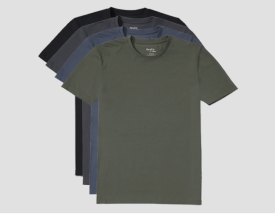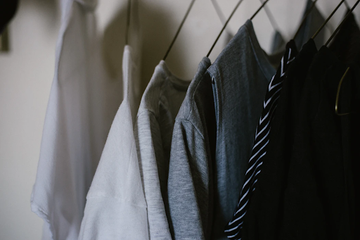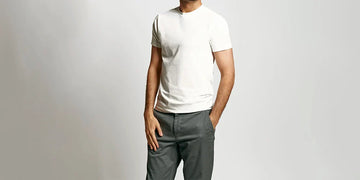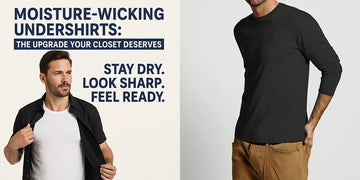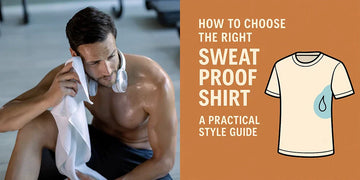Nobody wakes up thinking, “Today’s the perfect day to feel hot, sticky, and uncomfortable.”
But whether you're working a tough shift, pushing through a workout, or just trying to survive another blazing summer day, heat happens. And when your clothes don’t breathe? Things get sticky fast.
That’s where breathable fabrics come in. They’re the quiet heroes in your closet, keeping you cool, dry, and way more comfortable, even when life turns up the heat.
In this guide, we’re breaking it all down. What breathable fabrics actually are. Why they matter more than you think. Which ones are worth wearing. Plus, a peek into the latest fabric tech and eco-friendly upgrades that prove you don’t have to sweat your way through life or hurt the planet doing it.
What Is a Breathable Fabric
Think of breathable fabric like a built-in air conditioner for your clothes. It doesn’t blow cold air, but it does let heat and sweat escape instead of trapping it against your skin. The result? You stay cooler, drier, and much more comfortable.
Breathable fabrics let air flow in and out. At the same time, they pull moisture away from your skin and help it evaporate faster. That means less stickiness, less sweat, and way less regret when you step outside on a hot day.
This is especially helpful when you’re moving a lot, working hard, or just dealing with warm weather. Your body heats up, your skin starts to sweat, and instead of soaking your clothes, the fabric helps manage it.
If you want to get technical, the science term for all this is Moisture Vapor Transmission Rate, or MVTR. The higher the number, the better the fabric is at letting moisture out. You don’t need to memorize that, just know that the more breathable the fabric, the cooler and drier you’ll feel.
Why Breathable Fabrics Actually Matter
Breathable fabrics do more than just keep you from overheating. They help your body stay cool, dry, and comfortable whether you’re working, working out, or just out and about. By letting air in and moving sweat out, they reduce irritation, prevent chafing, and keep you feeling fresh. Bottom line: when your clothes breathe, you feel better.
Construction and Industrial Workwear
When you’re on your feet all day wearing PPE, breathability is more than comfort. It’s safety. It helps prevent overheating, reduces skin irritation, and keeps performance high from clock-in to clock-out.
Sportswear
If you’re moving, you’re sweating. Athletes need gear that pulls moisture away fast and keeps their body temp steady. Whether you're running marathons or just trying not to pass out in spin class, breathable gear is a must.
Outdoor Adventures
From mountain trails to fishing trips, breathable fabrics help you handle whatever nature throws at you. They regulate heat, manage sweat, and keep you dry even when you’re working up a storm.
Everyday and Summer Wear
Hot day. Long commute. Questionable air conditioning. Breathable fabrics are what stand between you and complete meltdown. From office clothes to backyard BBQ fits, comfort should always come with airflow.
Medical Textiles
In healthcare, breathable materials aren’t optional. They keep patients dry and help prevent infections. From hospital gowns to bed sheets, moisture control is critical.
Home Textiles
You know that cool side of the pillow feeling? Breathable bedding is like that, all night long. Better airflow means better sleep. And no one’s complaining about that.
The Best Breathable Fabrics
Time to meet the real MVPs. Natural or synthetic, each one brings something unique to the table. Some fabrics are soft and sustainable, others are built for performance and durability. And yes, there’s a difference between breathable fabrics vs moisture wicking fabrics. The key is finding the right match for your lifestyle, whether you're running errands or running marathons. Let’s break down which ones are worth wearing and why your closet (and your skin) will thank you.
Natural Fabrics
Cotton: Soft, breathable, and easy to wear. Cotton is the everyday go-to. Just remember it hangs onto moisture longer than synthetics.
Linen: Linen breathes like a champ thanks to its open weave. It’s perfect for summer, though it wrinkles easily and takes a few washes to soften up.
Merino Wool: Yes, wool can breathe. Merino regulates temperature, resists odors, and keeps you dry. Ideal for layering, hiking, and travel.
Bamboo: Super soft, antibacterial, and moisture-absorbent. Great for pajamas, socks, and baby gear. Just be aware the sustainability depends on how it’s processed.
Silk: Smooth, breathable, and lightweight. Silk regulates temp fairly well but needs a gentle touch when it comes to care.
Khadi: This handwoven fabric from India offers natural breathability and a rustic texture. Cool in summer, warm in winter, and big on sustainability.
Hemp: Durable, antibacterial, and cooling. Hemp gets softer over time and earns extra points for eco-credibility.
Synthetic and Blended Fabrics
Polyester: Engineered polyester is a performance powerhouse. It wicks sweat fast and dries even faster. Just watch for odor retention if it’s not blended.
Nylon: Lightweight, durable, and quick-drying. Great for outerwear and travel gear.
Spandex: Not breathable on its own, but when blended, it adds stretch and mobility without suffocating your skin.
Viscose or Rayon: Soft, breathable, and cool to the touch. It drapes beautifully but weakens when wet, so handle with care.
Micro Modal: Soft, silky, and ultra breathable. This semi-synthetic is a favorite for undergarments and base layers.
Chambray: Looks like denim but feels like a breeze. Perfect for lightweight summer shirts with extra style points.
Fabric Blends: The best of both worlds. Blends combine natural and synthetic properties to give you comfort, performance, and breathability all at once.
Fabric Tech That’s Upping the Breathability Game
The future is breathable, and it’s bringing receipts.
● Nanotechnology creates fabrics that repel water but still let vapor escape
● Hybrid fibers mix performance with comfort and sustainability
● Surface treatments boost moisture-wicking power
● Structural hacks like mesh panels and microporous membranes improve airflow without bulk
Sustainability Meets Performance
Breathability is no longer just about comfort. Consumers want to be eco-friendly too.
● Recycled polyester is replacing virgin fibers
● Organic cotton is leading the charge in natural fabrics
● Water-saving dyeing and biodegradable finishes are gaining traction
You can feel good and do good in the same outfit.
What to Look For in Breathable Fabrics
Use this checklist next time you shop.
Natural materials: Great for everyday breathability and comfort.
Loose weave: Allows more airflow to keep you cool.
Moisture-wicking: Helps pull sweat away from your skin to keep you dry.
Durability: Look for fabrics that can hold up after multiple washes.
Odor resistance: Key if you're wearing it in high-sweat situations.
Fabric blends with stretch: Offer flexibility and reduce friction so you can move freely without chafing.
Bonus: Breathability Helps Fight Chafing
Chafing is often caused by trapped moisture and friction. Breathable, moisture-wicking fabrics reduce both. Add a little stretch and you’ve got a recipe for chafe-free movement, whether you're walking the city or running a 10K.
FAQs About Breathable Fabrics
Are all natural fabrics breathable by default?
Not always. While many natural fabrics like cotton, linen, and Tencel are naturally breathable, the weave, weight, and finish of the fabric can affect how well it allows air to flow. A tightly woven cotton shirt, for example, might not breathe as well as a lightweight linen one.
Can synthetic fabrics really be breathable?
Yes, especially when they are designed for performance. Fabrics like polyester and nylon can be made with moisture-wicking properties and open weaves to increase airflow. Many athletic and outdoor brands use blends that are both breathable and durable.
How do I know if a fabric is moisture-wicking?
Look for it on the label or product description. Moisture-wicking fabrics are usually marketed that way. If you are testing at home, try putting a drop of water on the fabric. The faster it spreads and disappears, the better it is at pulling moisture away from your skin.
Is breathable fabric the same as quick-drying?
Not exactly, but they often work well together. Breathable fabrics allow air to pass through, while quick-drying fabrics are made to shed moisture fast. The best fabrics for activewear usually do both to keep you dry and comfortable.
Can breathable fabrics help prevent body odor?
They can definitely help. Breathable fabrics reduce the buildup of sweat, which is what bacteria feed on to cause odor. Some materials like Merino wool and bamboo are also naturally antibacterial, giving you extra odor protection throughout the day.
Bottom Line
No matter the season or setting, breathable fabrics make life more comfortable. We’ve covered the all-stars like cotton, Tencel, Merino wool, and bamboo, along with synthetic game-changers like polyester, nylon, and custom blends.
From workwear to workout gear, casual summer fits to high-tech outdoor gear, breathable fabrics are the unsung heroes of comfort and performance.
And the best part? The fabric world is getting smarter, cleaner, and more sustainable every day.
Shop Neat Apparel today and experience what breathable actually feels like.
